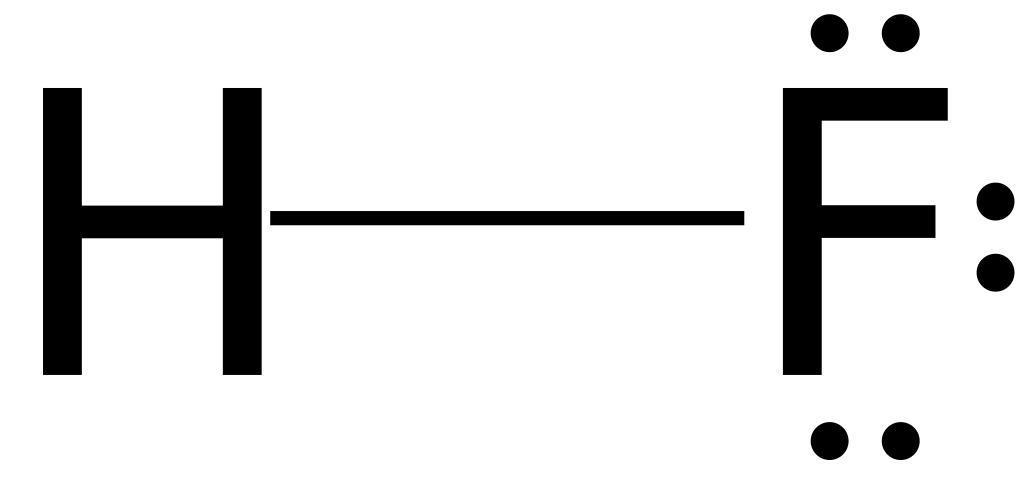
How many double bonds are in the Lewis structure for hydrogen fluoride, which contains one hydrogen atom and one fluorine atom?
Answer
437.4k+ views
Hint: Chemical bonding is a kind of pull force which is existing between the atoms or ions in a molecule. The existence of such forces gives increase to creation of chemical bonds which are found to be whichever ionic or covalent in nature.
Complete step by step answer:
There is no double bond present in Lewis structure for hydrogen fluoride.
This is for the reason that hydrogen needs only one electron and fluorine also needs one electron. (For completing octet arrangement)

Along these lines, they can ONLY FOR SINGLE BOND.
The substance bond present between the atoms or ions is essentially described by two sorts. One is framed of ionic bond and the other is shaped of covalent bond. The ionic bond is created by gift of electrons starting with one Species then onto the next species. The covalent bond is delivered by the sharing of electrons between the bonded species.
The electron density in ionic bonds keeps on the ions which are more electronegative and in covalent bonds the electron density lies in the middle of the two reinforced molecules. The reinforced ions in ionic bonds have electronegativity contrasts however covalent bonds have comparative electronegativity.
The compound given in this inquiry is hydrogen fluoride. Hydrogen fluoride is made out of a solitary connection between one hydrogen atom and one fluorine particle. The hydrogen particle has just a single electron in the peripheral or valence shell for framing bonds. The fluorine atom has \[7\] electrons in the furthest or valence shell for shaping bonds.
Accordingly, hydrogen is electropositive and fluorine is profoundly electronegative. Yet, the connection between \[HF\] isn't ionic in nature but instead it is covalent. The tremendous electronegativity contrast between the bonded ions in \[H - F\] permits the atom to shape intermolecular hydrogen bonds.
The connection between \[H - F\] is now and then considered as ionic. It is on the grounds that when hydrofluoric corrosive is treated with water it separates totally in water. The \[H - F\] is profoundly acidic as it promptly frees \[{H^ + }\] ions.
Note: The bond in \[H - F\] is alluded to as a polar covalent bond which additionally has ionic character. The particle is steady because of the essence of intermolecular hydrogen holding as a result of enormous electronegativity contrast between the reinforced atoms.
Complete step by step answer:
There is no double bond present in Lewis structure for hydrogen fluoride.
This is for the reason that hydrogen needs only one electron and fluorine also needs one electron. (For completing octet arrangement)

Along these lines, they can ONLY FOR SINGLE BOND.
The substance bond present between the atoms or ions is essentially described by two sorts. One is framed of ionic bond and the other is shaped of covalent bond. The ionic bond is created by gift of electrons starting with one Species then onto the next species. The covalent bond is delivered by the sharing of electrons between the bonded species.
The electron density in ionic bonds keeps on the ions which are more electronegative and in covalent bonds the electron density lies in the middle of the two reinforced molecules. The reinforced ions in ionic bonds have electronegativity contrasts however covalent bonds have comparative electronegativity.
The compound given in this inquiry is hydrogen fluoride. Hydrogen fluoride is made out of a solitary connection between one hydrogen atom and one fluorine particle. The hydrogen particle has just a single electron in the peripheral or valence shell for framing bonds. The fluorine atom has \[7\] electrons in the furthest or valence shell for shaping bonds.
Accordingly, hydrogen is electropositive and fluorine is profoundly electronegative. Yet, the connection between \[HF\] isn't ionic in nature but instead it is covalent. The tremendous electronegativity contrast between the bonded ions in \[H - F\] permits the atom to shape intermolecular hydrogen bonds.
The connection between \[H - F\] is now and then considered as ionic. It is on the grounds that when hydrofluoric corrosive is treated with water it separates totally in water. The \[H - F\] is profoundly acidic as it promptly frees \[{H^ + }\] ions.
Note: The bond in \[H - F\] is alluded to as a polar covalent bond which additionally has ionic character. The particle is steady because of the essence of intermolecular hydrogen holding as a result of enormous electronegativity contrast between the reinforced atoms.
Recently Updated Pages
Master Class 11 Accountancy: Engaging Questions & Answers for Success

Glucose when reduced with HI and red Phosphorus gives class 11 chemistry CBSE

The highest possible oxidation states of Uranium and class 11 chemistry CBSE

Find the value of x if the mode of the following data class 11 maths CBSE

Which of the following can be used in the Friedel Crafts class 11 chemistry CBSE

A sphere of mass 40 kg is attracted by a second sphere class 11 physics CBSE

Trending doubts
10 examples of friction in our daily life

One Metric ton is equal to kg A 10000 B 1000 C 100 class 11 physics CBSE

Difference Between Prokaryotic Cells and Eukaryotic Cells

State and prove Bernoullis theorem class 11 physics CBSE

What organs are located on the left side of your body class 11 biology CBSE

How many valence electrons does nitrogen have class 11 chemistry CBSE




